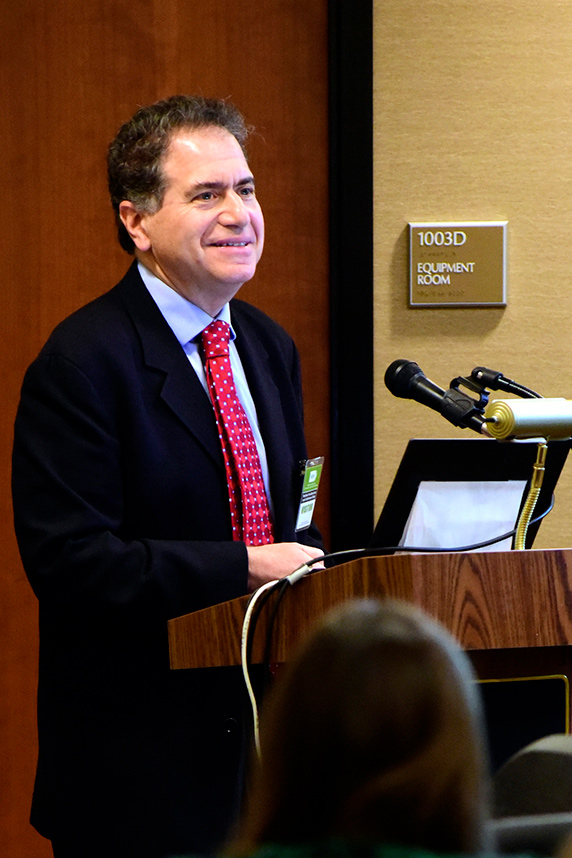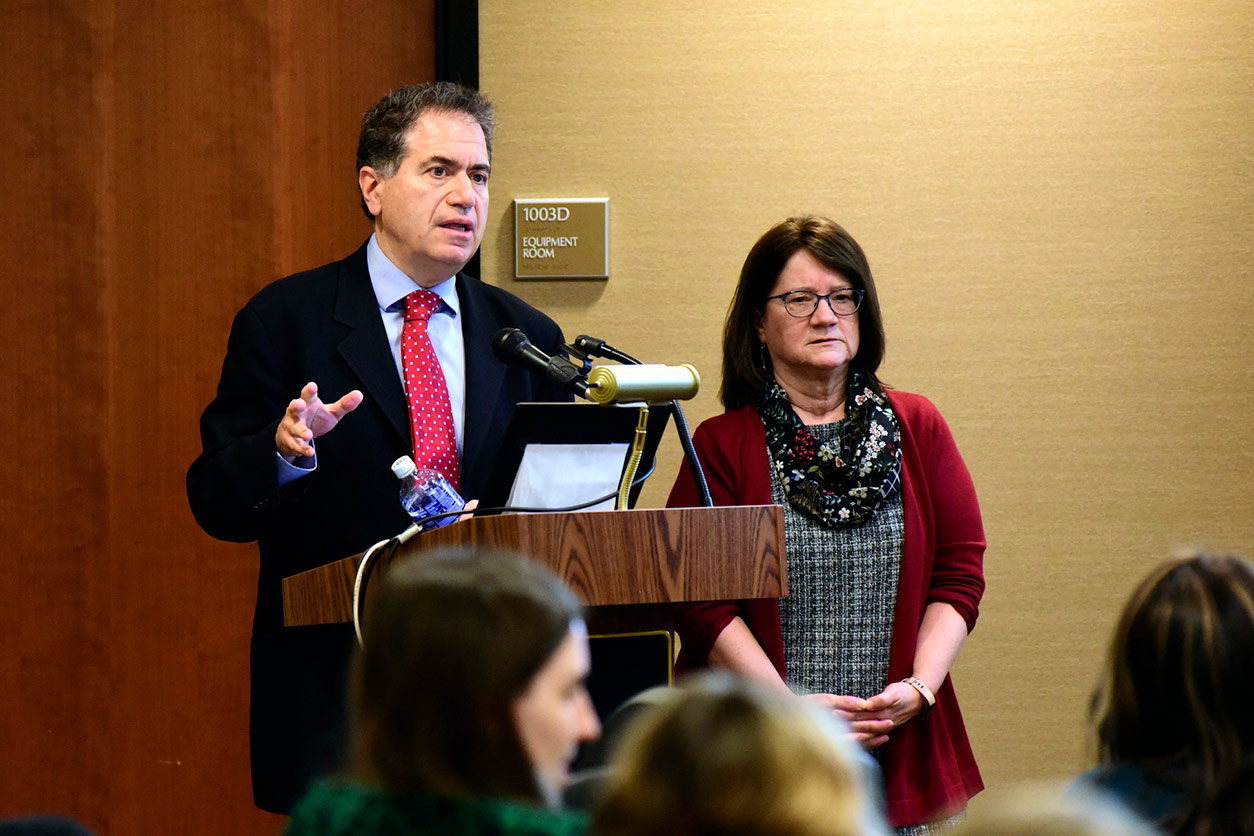 Infection, malnutrition, low oxygen, stress, and toxicant exposures influence birth outcomes and health effects that appear in later life, Brown explained. (Photo courtesy of Steve McCaw)
Infection, malnutrition, low oxygen, stress, and toxicant exposures influence birth outcomes and health effects that appear in later life, Brown explained. (Photo courtesy of Steve McCaw)Discovering prenatal conditions that influence a person’s later development of psychiatric and other brain disorders is the research focus of Alan Brown, M.D., from Columbia University. The NIEHS grantee spoke Jan. 16 as part of the institute’s Keystone Science Lecture Seminar Series.
Looking across the lifespan, Brown studies how experiences before birth may manifest in later years with such health outcomes as schizophrenia, autism spectrum disorder (ASD), and attention deficit hyperactivity disorder (ADHD). In his newest research project, he hopes to determine whether markers of oxidative stress in a pregnant woman’s blood are connected with schizophrenia and ASD in children.
Cindy Lawler, Ph.D., head of the NIEHS Genes, Environment, and Health Branch, hosted Brown’s talk. NIEHS funding for autism and neurodegenerative diseases are among the research programs she oversees. “Alan’s research in schizophrenia has been key to moving beyond observations about risk from infectious agents to [focus on] underlying inflammatory mechanisms and biomarkers,” she said, “and further, the relevance of inflammation to potential links between psychiatric disorders and environmental exposures.”
Early work on influenza
Brown described how his earlier work built the scientific basis for his current studies. For example, in 2004, he reported links between a woman’s influenza infection during pregnancy and her offspring’s later risk of schizophrenia. Related research on rubella was published in 2001.
“Most fetuses don’t end up with these outcomes later in life, which suggests a critical role for susceptibility genes and environmental factors,” he said, pointing to needed research.
Inflammation — a common factor
Inflammation is a feature of many of the prenatal conditions Brown has studied. He suggested it might hold the mechanism for neurodevelopmental changes. An established marker of inflammation is called C-reactive protein (CRP). Higher blood levels of this protein suggest that the immune system is responding to bacterial or viral infection, or other challenges.
A 2013 NIEHS news release described key findings of Brown’s study of this biomarker. “The risk of autism among children in the study was increased by 43% among mothers with CRP levels in the top 20th percentile, and by 80% for maternal CRP in the top 10th percentile,” he and his coauthors wrote in the paper.
 Musa Kana, M.D., Ph.D., center, from the NIEHS Genetics, Environment & Respiratory Disease Group, listened closely to Brown. Behind him, left, is Lingamanaidu Ravichandran, Ph.D., from the Exposure, Response, and Technology Branch. (Photo courtesy of Steve McCaw)
Musa Kana, M.D., Ph.D., center, from the NIEHS Genetics, Environment & Respiratory Disease Group, listened closely to Brown. Behind him, left, is Lingamanaidu Ravichandran, Ph.D., from the Exposure, Response, and Technology Branch. (Photo courtesy of Steve McCaw)Chemical insults
Like infection, the body may respond to chemical insults with host responses, including inflammatory action, oxidative stress, and endocrine changes. Brown is particularly interested in a group of chemicals called persistent organic pollutants (POPs) because they break down slowly or not at all in the environment.
With NIEHS funding, he and his research team used data from the Finnish Prenatal Studies, or FiPS, to look for connections between diagnoses of ASD and maternal levels of polychlorinated biphenyls (PCBs) and a metabolite of the pesticide DDT, called DDE. In 2018, he published the first study linking a maternal biomarker of DDT exposure with ASD in offspring.
“Research on maternal environmental chemicals and these outcomes has been limited,” said Brown. “My new work is based on the idea that schizophrenia, ADHD, and other disorders share risk factors with ASD,” he said.
 “Maternal exposure to DDT and DDE are associated with premature birth and small-for-gestational-age status, both of which are well-replicated factors for developing ASD,” said Brown. Lawler, right, oversees the NIEHS autism grant program. (Photo courtesy of Steve McCaw)
“Maternal exposure to DDT and DDE are associated with premature birth and small-for-gestational-age status, both of which are well-replicated factors for developing ASD,” said Brown. Lawler, right, oversees the NIEHS autism grant program. (Photo courtesy of Steve McCaw)Oxidative stress
Oxidative stress is one cause of inflammatory processes. “[Oxidative stress] is important in many diseases, not just psychiatric disorders but other outcomes such as neurological and cardiovascular disorders and cancer,” Brown said. “Maternal oxidative stress is also related to abnormal fetal development and neonatal oxidative stress.”
Maternal oxidative stress is further linked to several ASD risk factors, including smoking and exposure to POPs. The fetal brain is vulnerable to such damage because of its high oxygen use and its decreased capacity to respond to insults.
Citations:
Brown AS, Begg MD, Gravenstein S, Schaefer CA, Wyatt RJ, Bresnahan MA, Babulas V, Susser ES. 2004. Serologic evidence for prenatal influenza in the etiology of schizophrenia. Arch Gen Psychiatry 61(8):774–780.
Brown AS, Cohen P, Harkavy-Friedman J, Babulas V, Malaspina D, Gorman JM, Susser ES. 2001. A.E. Bennett Research Award. Prenatal rubella, premorbid abnormalities, and adult schizophrenia. Biol Psychiatry 49(6):473–486.
Brown AS, Cheslack-Postava K, Rantakokko P, Kiviranta H, Hinkka-Yli-Salomaki S, McKeague IW, Surcel HM, Sourander A. 2018. Association of maternal insecticide levels with autism in offspring from a national birth cohort. Am J Psychiatry 175(11):1094–1101.
Brown AS, Sourander A, Hinkka-Yli-Salomaki S, McKeague IW, Sundvall J, Surcel HM. 2013. Elevated maternal C-reactive protein and autism in a national birth cohort. Mol Psychiatry 19(2):259–264.
Brown AS, Hooton J, Schaefer CA, Zhang H, Petkova E, Babulas V, Perrin M, Gorman JM, Susser ES. 2004. Elevated maternal interleukin-8 levels and risk of schizophrenia in adult offspring. Am J Psychiatry 161(5):889–895.









